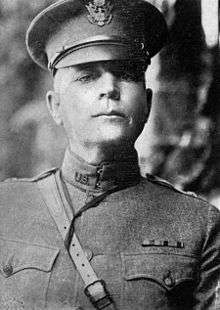Palmer E. Pierce
| Palmer Eddy Pierce | |
|---|---|
 Pierce in 1919, as the commander of the 27th Infantry Division | |
| Born |
October 23, 1865 Savannah, Illinois, U.S. |
| Died |
January 17, 1940 (aged 74) New York City, New York, U.S. |
| Buried at | United States Military Academy Post Cemetery, West Point, New York, U.S. |
| Allegiance |
|
| Years of service | 1916–1930 |
| Rank | Brigadier general (at time of retirement) |
| Battles/wars | |
| Awards | |
| Spouse(s) | Agnes Young Pierce |
| Other work |
First President of NCAA Assistant to President of the Standard Oil Company |
Palmer Eddy Pierce (October 23, 1865 – January 17, 1940) was a United States Army brigadier general who commanded the 54th Infantry Regiment on the Western Front of World War I. He was the first president of the National Collegiate Athletic Association (NCAA).
Early life and education
Palmer E. Pierce was born in Savanna, Illinois,[1] to Henry C. Pierce and Laura Shepard. He was the second of three brothers. He grew up in Traer, Iowa,[1] going on to attend Grinnell College and the US Military Academy at West Point, New York. He received his lieutenant's commission in 1891. He became athletic director at West Point for a short time in the early 1890s, managing the first Army football team.[2]
Early service
Pierce first served in the Spanish-American war of 1898 during the Invasion of Cuba, Puerto Rico, and the resurrection of the Philippines. He served during the Boxer Rebellion in 1899. In 1901 he graduated from the Army War College and the school of the line and the staff class at Fort Leavenworth.[3]
Pierce was the first president of the NCAA, taking office in 1906.[4] At the first organizational meeting in December 1905, he emphasized the importance of "home rule", which allowed any institutions that joined the NCAA to still keep their independence.[5] He was a severe critic of the "old" rules committee,[6] saying that they were "a self-constituted, self-perpetuating and irresponsible body, which, in order to make the rules more favorable to the playing area available at particular institutions, had degraded a once noble sport to a brutal gladitorial contest".[6]
He served in the Villa Expedition in 1916.[3]
Service
In 1917, Pierce became an aide to United States Secretary of War Chauncy B. Baker. On one occasion after the declaration of war, when Pierce appeared before the Senate Finance Committee to discuss how to spend the three billion dollars requested to send to the War Department, he declared: "Clothing, cots, camps, food, pay … And we may have to have an army in France!". "Good Lord!" said Virginian Senator Thomas S. Martin. "You're not going to send soldiers over there, are you?"[7] Pierce became the Director of Purchases for the War Industries Board after its establishment in 1917.[8]
In the later half of 1917 to the early part of 1918, Pierce served as commander of the 27th Infantry Division and the 54th Infantry Regiment. While he was under British command, he was ordered to the Battle of Bellecourt; there the Australians provided invaluable supplies and lessons, including hot meals to the front lines, given the lack of supplies on the front line.[9] In late 1918, he became the Assistant Chief of Staff of the AEF. He was promoted to brigadier general and earned two Distinguished Service Medal and the British Order of the Bath for his actions as the commander of the respective formations.[10]
Death and legacy
After retiring from the Army, Pierce became an assistant to the President of the Standard Oil Company. He died in New York City on January 17, 1940.[11]
His widow, Agnes Young Pierce (1870-1961), left a bequest of $1 million to the Association of Graduates of West Point, which was used to establish the Palmer E. Pierce Memorial Fund.[12]
References
Citations
- 1 2 "Palmer E. Pierce Memorial Fund". Assembly. 20: 32. 1961.
- ↑ Higgs 1995, p. 220.
- 1 2 Causey 1917, p. 408.
- ↑ Whittingham 2001, p. 37.
- ↑ Smith 2003.
- 1 2 Nelson 1994, p. 106.
- ↑ Kennedy 2004, p. 144.
- ↑ Himmelberg 1962, p. 10.
- ↑ Blair 2011.
- ↑ Rinaldi 2004, p. 37.
- ↑ Stachon, Von M. (2007). "Palmer Eddy Pierce". Retrieved 18 May 2014.
- ↑ "West Point Plans Pierce Memorial". The Evening News. 1 December 1961. p. 7A. Retrieved 20 May 2015.
Bibliography
- Blair, Dave (2011). The Battle of the Bellicourt Tunnel: Tommies, Diggers and Doughboys on the Hindenburg Line, 1918. Frontline Books. ISBN 1-84832-587-8.
- Causey, Edward H. (1917). "Advising Uncle Sam How to Spend $19,000,000,00". The Rotarian. Rotary International. 11 (3): 408.
- Higgs, Robert J. (1995). God in the Stadium: Sports and Religion in America. University Press of Kentucky. ISBN 0-8131-1923-5.
- Himmelberg, Robert F., ed. (1962). Antitrust and Regulation During World War I and the Republican Era, 1917–1932. New York, NY: Taylor & Francis. ISBN 0-8153-1406-X.
- Kennedy, David M. (2004). Over Here: The First World War and American Society. Oxford, UK: Oxford University Press. ISBN 0-19-517399-6.
- Nelson, David M. (1994). The Anatomy of a Game: Football, the Rules, and the Men who Made the Game. University of Delaware Press. ISBN 0-87413-455-2.
- Rinaldi, Richard A. (2004). The U.S. Army in World War I – Orders of Battle. Takoma Park, MD: Tiger Lily Publications. ISBN 0-9720296-4-8.
- Smith, Ronald A. (2003). Play-by-Play: Radio, Television, and Big-Time College Sport. JHU Press. ISBN 0-8018-7692-3.
- Whittingham, Richard (2001). Rites of Autumn: The Story of College Football. Simon & Schuster. ISBN 0-7432-2219-9.